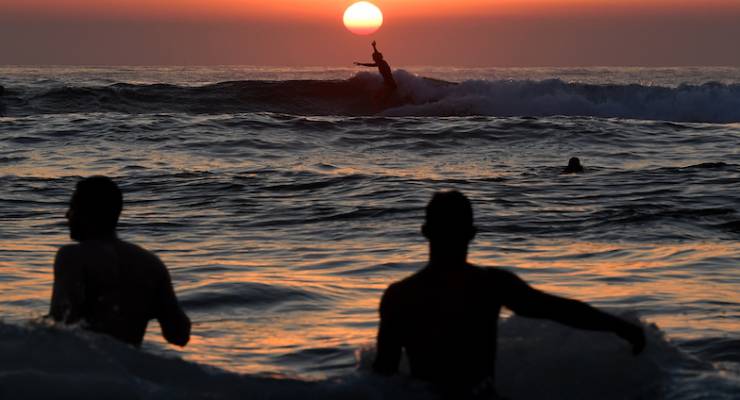
I wonder what people around the world answer when asked what defines “Australia” or “Australian culture”.
Perhaps it’s a few distinctive food items: lamingtons, Tim Tams and meat pies; or instead it’s climate-denial, racism and an over-reliance on the Murdoch press. Maybe some people, when considering what defines us, imagine Western Desert dot painting, the music and bark-painting of the Yolngu people and, sadly, fake art boomerangs.
However, I suspect that what defines Australia to most of the rest of the world is beaches — how beautiful our beaches are and how much Australians adore them.
Beaches loom large in Australia’s identity. The Sydney suburb of Bondi is known around the world, predominantly because of its beach. Australia’s best remembered and almost certainly most culturally significant modern race riot, in Cronulla, started over a dispute at a beach and, to my mind, was driven by white Australia’s belief that beaches hold a sacred significance in its culture.
The south coast of Western Australia, from which my Noongar family arose, is renowned for its beautiful white beaches. The town of Esperance, at the eastern end of south-coast Noongar country, tends to self-promote with pictures of kangaroos on pristine white beaches. Can it get more Aussie than that? These pictures, Kangaroos on a beach, are the Instagram posts many tourists try to capture when they visit the area.
It can hardly be disputed that the beach plays an important part in the culture of Australia. Even I have spent much of my life on beaches, as a child holidaying down the coast from Perth and as an adult walking, fishing and caravanning. My favourite place on earth is a rock on the beach on the south coast of WA. My will specifies that my ashes are to be cast into the sea there.
Love of beaches seems to know no boundaries; people of all cultural backgrounds and political affiliations in Australia love the beach. With 90% of Australians living within 100kms of the coast it could be argued that beaches are the only thing capable of uniting us.
This is why coastal erosion, particularly the erosion of beach sand, has the potential to rip into the heart of all that Australians think we are.
I don’t know for certain what will happen to Australia and the nation’s identity if certain famous beaches disappear; or what will happen if iconic coastal towns are swept away into the sea. It will, however, be a deep wound in what we think of as our culture. The loss will puncture the heart of what this nation thinks it is.
The problem is, of course, that this wounding assault is already happening. Industrial modification of a coast changes the currents; dredging can also modify them. Changing the current sweeps sand from the beaches, helping the ocean eat the coast. Storms are more frequent now. One big storm can move an entire beach.
When we factor in sea-level rise, the effects on beaches and coastal towns can be brutal and catastrophic. Some beaches may be saved in the short term, as local governments import or transfer sand, but eventually much of the current coast of Australia will be lost forever.
This includes iconic buildings, beloved beaches and some of the most expensive real estate on the continent.
There are already victims, some of which you are not aware of; some whose plight is ignored by the news media that would rather show you a mansion falling into the sea.
The Torres Strait Islands (TSI), a group of islands populated almost entirely by Indigenous peoples, are in genuine danger of being swept away by sea-level rise and coastal erosion. Their danger is not in some distant future. Some island communities have already been affected.
But the problem is not unique to the TSI communities. Aboriginal people around the continent hold coastal areas sacred — areas which will be permanently changed by coast alteration (by governments), coastal erosion and sea level-rise.
I often question what happens to a culture, to stories, to people when those cultures arose in places that no longer exist. I wonder what will happen when vast areas of Australia’s coast have been eroded away, when suburbs and entire cities on the coast become unliveable, when increased storms and more dangerous bushfires destroy what’s left.
It’s impossible to imagine what changes may occur to Australia’s identity but there is one thing we can be relatively certain of: the upheavals of today will change Australia.
Claire G. Coleman is a writer from Western Australia and the author of Terra Nullius and The Old Lie. She identifies with the South Coast Noongar people. Her family are associated with the area around Ravensthorpe and Hopetoun.








This is not yet hitting popular mainstream consciousness, as the bushfires are the major concern at the moment. In fact the bushfires providing a precedent of how climate change will impact on the cultural assumptions and mythology of coastal Australia.
It’s ironic Claire, that while we mythologise the Bush, it is in fact the beach that is our true home. Not just for indigenous peoples, or those of us with no native heritage, but for human beings. Our ancestors, in evolutionary terms, emerged from the sea and those of us lucky enough to visit feel no more at home than when we are there.
Thanks for your thoughts.
Clare, may I conjecture your enjoyment of Burbank, J. and Cooper, F. (2011) ‘Empires in World History’
which is a comprehensive analysis of ’empire’; ancient and modern. Your edification as to world history will also incur a significant improvement.
Suffice to observe that from the first civilisations (i.e. where formal administration existed and similarly formal records were maintained in a WRITTEN form) circa 3,500 years ago there have been any number of events that have destroyed human habitats (towns and cities of one prefers). The events include major earthquakes, volcanic eruptions, famines and floods. The most spectacular was ‘Toba’ about 70,000 years ago that had the effect of almost zapping Homo sapiens. As to how close Homo sapiens came to extinction is a matter of discussion (on the facts – as they exist) but the severity of event is not in dispute.
As to ‘Australians’ identifying with the “bush” – this myth was discredited in the 1890s. The Bulletin,
being very “pro-bush” it nevertheless published a poem by Henry Lawson with the title “Up the Country”.
Yeah; the ambiguity of the title was effective even in July 1892 when The Bulletin accepted publication (different today – huh – considerably more egalitarian in the late 19th century)!
A number of the Heidelberg (Art) School endorsed Lawson’s view of, so called, city bushmen who banged-on
about “the bush” from A.B. Paterson to the later Miss Miles Franklin. In other words, 130 years ago the notion
of Australians and the bush was a myth; the proportional concentration of regional and city populations has increased, somewhat, over that period but it was very stark at the end of the 19th century.
As to there being a myth of “the “beach” – I really don’t know. Yes, “the beach” is a big deal in Oz and NZ but
I don’t think the beach deserves over-enthusing but there is a very great tendency for the general population
to do so.
As to my “ancestry” (it seems de jure to include it nowadays(!)) it is a mixture of squat-ocracy, religious
nutter-ism, substance abuse in a professional manner thus evading detection, alcoholism, some domestic violence in an otherwise publicly respectable professional upper middle class environment attendant with former presidencies of Lion’s clubs etc.
Only too happy to debate any of the above with you Claire.
I grew up with the evolution of surfing and my children are part of the beach culture. I see what’s coming and I see our beaches washed away by rising oceans and the end of the beautiful era of surfing.
It doesn’t matter how hard I push, and how hard I try, I just don’t seem able to get through to the surfing fraternity that we need to stop burning fossil fuel and vote for politicians who back renewable clean energy.